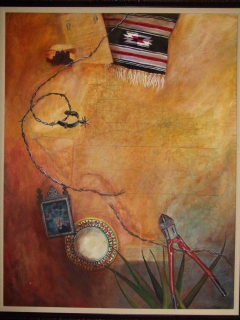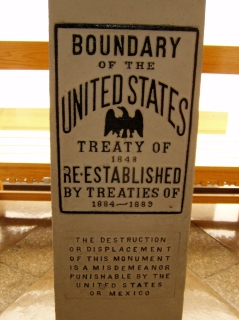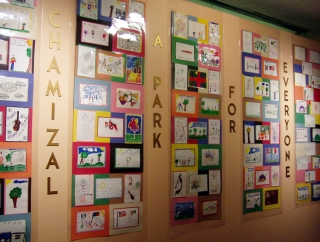El Paso, Texas
NPS Website

WHAT IS IT?
An area along the Mexican-American border whose rightful possession was vehemently disputed for over a century. The Park commemorates the August 29, 1963 compromise that ended the conflict. The Site’s mission is to celebrate the international friendship through the sharing of the distinct local culture through plays, musical concerts, art displays, murals and folk festivals.
BEAUTY (4/10)
Chamizal NMEM is designed for use and participation. It hardly matters that the sun has seared much of the grass on the Park’s grounds; the lawns are in disrepair. No matter. Festivals take place here. Dancing, picnicking and celebrating would have ruined the grass anyways.
The view from the Site is not the jagged mountains of El Paso, but the International Border and the Bridge of the Americas. The Mexican customs warehouse is visible just a short distance away as are smoke billowing tractor-trailers and the U.S. border control. The Site’s surroundings are not pretty.
Painted on the Site building itself is a striking mural depicting Border Culture, American and Mexican, and painted in bright colors. The artistic theme continues inside the Chamizal NMEM. Local artwork is showcased in Los Paisanos Gallery and throughout the Museum. A 500-seat indoor theater hosts movies, recitals and plays regularly.
At Chamizal NMEM, the beauty comes not from the drab building interiors or the manic surroundings but from the artistic expressions of those who live along the border in El Paso and Ciudad Juarez. It is their music, art, and dancing that enlivens this Site.
HISTORICAL INTEREST (6/10)
Chamizal NMEM is a story of confusion, anger and healing through successful diplomacy. The 1848 post Mexican-American War Guadalupe Hidalgo Treaty designated the U.S.-Mexico border as the Rio Grande. Problem is, rivers move. By 1895, rainfall, flooding and erosion had moved the River’s course southward leaving 600 acres of disputed land. Mexico believed it to be theirs, based on the geography of the original treaty, while the Americans claimed the territory because now it was north of the Rio Grande.
International boundary courts made decisions and nobody listened. Anger pervaded while El Paso and Juarez continued to grow. After over a century of anger, the Chamizal Treaty was negotiated in 1963 and signed in 1967. The land was divvied up and a permanent artificial river channel was built.
The disputed land never led to war between our two neighboring countries but its solution shows that compromise and peace can be achieved through an open discourse. Nowadays, Juarez and El Paso feel like one city. This Site’s aim is to foster this togetherness and cultural exchange after such a long period of disagreement. It is working.
CROWDS (6/10)
We were joined by a handful of people as we walked through the exhibits explaining the Site’s history. They did not affect our visit. Had we traveled to the Site for a musical or dramatic performance, we believe that the crowd rating would have been much higher.
The Site is located less than a mile from Interstate 10 along U.S. Route 62, Paisano Drive. If you are going the Chamizal NMEM, it is imperative that you take the last exit off the Patriot Freeway and onto U.S. Route 62. If you don’t you will be at the Port of Entry into Mexico. All facilities at the Site are at ground level and wheel chair accessible. Paved paths lead around the Park’s grounds.
CONCESSIONS/BOOKSTORE (4/5)
The Chamizal NMEM Bookstore hosts a wall of children’s books, several of them bilingual; a collection of prints and posters from local artists; and a set of titles that could form required reading lists for a semester-full of cultural studies courses. Books devoted to Musica Tejana, Black Indians, Country Music, and Las Soldaderas kept Gab’s attention while Michael wandered the museum. One Ranger was clearly proud of the Site’s library. He asked if we needed any recommendations or assistance. He had read each book there – at least twice.
COSTS (4/5)
Entry into the Site is free. Shows at the theatre vary in price range. Check the website for more information.
RANGER/GUIDE TO TOURIST RATIO (4/5)
Three very helpful Rangers staffed the desk. All made a point to call out to us and ask if we had any questions. They were armed with a satellite map of the Chamizal marked with the Rio Grande’s different courses through the years. They were eager to tell the story of the dispute and resolution. In fact, everybody in El Paso and Juarez knows the history and recites the diplomacy tale with pride and respect. Ranger talks do not happen daily but do occur before every theatre event.
TOURS/CLASSES (4/10)
All exhibits and panels at Chamizal NMEM include text in both Spanish and English. This leaves less room for words but promotes inclusion. This Site is for everyone who lives in the area. A 25-minute introductory film begins by explaining the history of the Chamizal but spends most of its time on showing the dancing, acting and singing that takes place here. If you can’t come to El Paso during a Chamizal performance, then the video is the next best thing. The switch in emphasis from a history lesson to a cultural celebration is important and laudable.
FUN (4/10)
We were not at Chamizal for any of the numerous weekend festivals or outdoor celebrations held throughout the year. We didn’t come to the Site to hear a lecture or watch a performance in the beautiful theatre. Our visit was on a quiet Monday morning. The gallery’s exhibits were in the process of being rotated. The only activity on the lawn was a handful of NPS maintenance workers clearing leaves. The Site is more like a stage or a setting than an attraction in itself. It felt like we arrived at the party on the wrong day.
To fully appreciate the values Chamizal is trying to promote, time your visit to coincide with a folk festival, a concert, a ballet. Enjoy the Site as a cultural center, a meeting place, a social hall.
At Chamizal, all cultures and all performers are equal. One week in December hosts an internationally known ballet troupe on the same stage that welcomes students from a local piano teacher to give their annual recital. Chamizal engages the communities of El Paso and Juarez and in return, they offer artists from all cultures an inviting arena for their crafts.
The Chamizal NMEM is a special place and unique representative of the National Parks System. Its first priority is not the external tourism trade; it is to bring neighbors of two countries together. This Park is for the people of El Paso and Juarez.
TOTAL 44/80
www.usa-c2c.com
© 2004-06